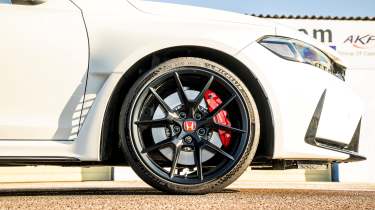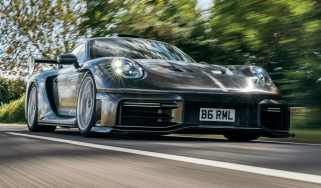Honda Civic Type R (FL5) – engine, gearbox and technical highlights
A masterclass in powertrain engineering, perfectly paired to a highly tuned chassis
The new Civic Type R’s bodyshell is stiffer by 15 per cent thanks to extensive use of adhesives in its construction, and both wheelbase and track widths have grown by 36mm and 15mm respectively. A lesser company would have dropped all the previous-generation hardware into the new body, tweaked the motor ever so slightly to find a pinch more power and torque and left the rest alone.
Not Honda. The basic nuts and bolts might be almost entirely carry-over, but the CTR development team threw themselves into fastidiously, meticulously and relentlessly exploring ways of making everything just that little bit better.
Honda claims a weight of 1429kg, and in our independent testing found it weighed 1437kg with a full tank of fuel. This is 28kg heavier than the last FK8 we weighed, a variation Honda explains comes almost entirely from the extra adhesive and strengthening in the bodywork.
The K20C1 engine is more impressive than ever. Yes, there are useful bumps in both power and torque with peaks of 324bhp and 310lb ft (up 8bhp and 15lb ft respectively over the FK8), but it's the way in which the motor responds that makes the most significant and tangible difference. Contributing to this is an 18 per cent lighter flywheel, reducing inertia off the end of the engine by 25 per cent.
This lack of inertia has always been so typical of Honda's high-performance VTEC motors. Where pretty much every turbocharged four-cylinder hot hatch feels like it's powered by an unexceptional engine that does the numbers thanks to forced induction, the Civic's engine feels like a sharply tuned naturally aspirated motor that's been further boosted by a turbocharger. It's a small but crucial distinction.
Mated to the snappy, beautifully precise and – yes – painstakingly honed six-speed manual transmission it's a powertrain to bring a smile to your face. There's a throttle-blip function, which can be adjusted via the dynamic options and makes for perfect rev-matched downshifts. It's clever enough to allow you to do your own without having to disable the system, but you can switch it off if you dig deep enough into the menus.
Those driver mode menus are the real game-changer compared to the FK8, with a new individual mode that allows you to change the steering, suspension, engine mapping, engine noise, auto-blip function and the dial pack. Accessible through a switch on the centre console, the default mode for the Type R is Sport, with Comfort and +R modes on either side.



